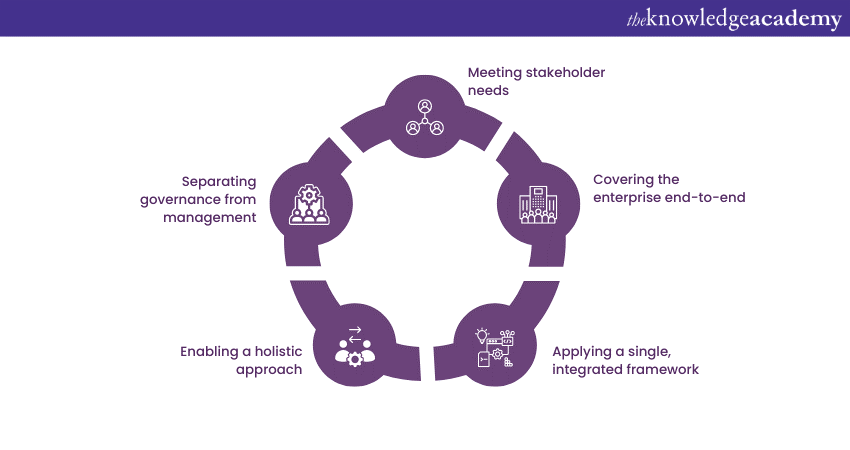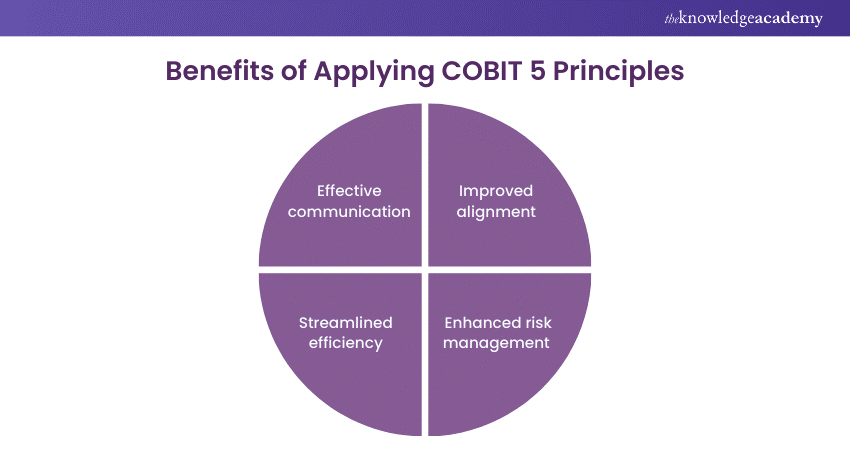We may not have the course you’re looking for. If you enquire or give us a call on +65 6929 8747 and speak to our training experts, we may still be able to help with your training requirements.
Training Outcomes Within Your Budget!
We ensure quality, budget-alignment, and timely delivery by our expert instructors.

In the Information Technology (IT) Governance and Management domain, the COBIT 5 Principles shine as guiding stars, offering a comprehensive roadmap for organisations to navigate the complexities of the modern digital era.
These Principles serve as pillars of wisdom, emphasising stakeholder alignment, holistic approaches, integrated frameworks, and clear role separation. With COBIT 5, organisations can bridge gaps, streamline processes, and forge a new path toward efficiency, accountability, and strategic success.
Thus, it is the time for organisations willing to build robust IT infrastructure that they must learn about these guiding Principles. So, read this blog to discover the COBIT 5 Principles for effective Governance and Management of enterprise IT, ensuring alignment with business objectives.
Table of Contents
1) Introduction to COBIT 5
a) Principle 1: Meeting stakeholder needs
b) Principle 2: Covering the enterprise end-to-end
c) Principle 3: Applying a single, integrated framework
d) Principle 4: Enabling a holistic approach
e) Principle 5: Separating Governance from Management
2) Implementing COBIT 5 Principles
3) Benefits of applying COBIT 5 Principles
4) Conclusion
Introduction to COBIT 5
Information and technology drives innovation, efficiency, and competitive advantage. However, it can be complex to manage IT resources, align them with business goals, and ensure they operate within a robust Governance framework. This is where Control Objectives for Information and Related Technologies 5 (COBIT) stands as a guiding light for organisations seeking a comprehensive approach to IT Governance and Management.
There are a set of COBIT 5 Principles, practices, and guidelines that facilitate effective Governance and Management of IT resources. COBIT 5, the fifth iteration of this framework, marks a significant evolution that adapts to the ever-changing technology landscape while addressing the need for seamless integration between IT and business functions.

Principle 1: Meeting stakeholder needs
COBIT 5 recognises this reality and places "Meeting Stakeholder Needs" as its framework's first and foremost principle. This principle serves as the bedrock upon which the entire structure of COBIT 5 is built, It emphasises the criticality of aligning IT activities with the expectations and requirements of stakeholders.
Stakeholders, in the context of COBIT 5, encompass a broad spectrum, ranging from customers and partners to employees and regulators. Each stakeholder group carries distinct expectations, concerns, and demands. Understanding these nuanced needs requires a comprehensive assessment that goes beyond superficial understanding.
Understanding stakeholder needs is not an isolated exercise but the prelude to a more profound alignment with the organisation's business objectives. COBIT 5 advocates for a seamless connection between stakeholder expectations and the organisation's broader strategic goals. This linkage ensures that IT initiatives are not pursued in isolation but contribute directly to the organisation's success.
Thus, principle 1 of COBIT 5 serves as a bridge between the world of stakeholders and the realm of IT. It is a testament to the recognition that the success of IT initiatives is determined not just by technical prowess but by their ability to fulfil the aspirations and demands of those who hold a stake in the organisation's journey.
Principle 2: Covering the enterprise end-to-end
Organisations are composed of intricate webs of processes, functions, and departments; it is easy for isolated efforts and siloed thinking to impede progress. COBIT 5 addresses this challenge by highlighting "covering the Enterprise End-to-End" as its second fundamental principle.
This principle underscores the importance of adopting a holistic perspective that transcends individual departments and views the organisation as a unified whole.
It advocates for an integrated perspective that considers how various elements of the organisation interact and impact each other. By embracing this holistic view, organisations can identify interdependencies, optimise processes, and uncover opportunities for efficiency enhancement.
Siloed departments and processes hinder collaboration, communication, and overall efficiency. COBIT 5 challenges organisations to break down these silos by fostering cross-functional cooperation. When IT and business units collaborate effectively, they can leverage diverse expertise and viewpoints to arrive at more robust solutions.
Ready to delve into the world of COBIT Governance and Management? Our COBIT Foundation course is your gateway to mastering the fundamental principles and practices.
Principle 3: Applying a single, integrated framework
Organisations often navigate many frameworks, methodologies, and best practices, making simplicity and coherence increasingly valuable. COBIT 5 recognises this need and places "applying a single, integrated framework" as its third pivotal principle.
This principle advocates for adopting a unified IT Governance and Management approach, streamlining processes and enhancing overall efficiency. The principle of applying a single, integrated framework acknowledges the challenges posed by the proliferation of disparate practices. Using multiple frameworks can lead to confusion, duplication of efforts, and inefficiencies.
COBIT 5 encourages organisations to embrace a streamlined approach in harmonising Governance and Management processes into a coherent structure. A unified framework not only simplifies processes but also enhances overall efficiency. When everyone in the organisation adheres to the same set of practices, there's a reduction in ambiguity and confusion.
This, in turn, accelerates decision-making and decreases the learning curve for new employees. It also facilitates the measurement of performance against standardised benchmarks.
Principle 4: Enabling a holistic approach
Organisations often navigate many frameworks, methodologies, and best practices, making simplicity and coherence increasingly valuable.COBIT 5 recognises the need for a comprehensive mindset and places "Enabling a Holistic Approach" as its fourth guiding principle. This principle underscores the significance of addressing business risks and opportunities from a broader viewpoint transcending narrow silos.
The principle of enabling a holistic approach emphasises the importance of considering risks and opportunities not just from a technical standpoint but also their impact on business objectives. COBIT 5 encourages organisations to take a step back and assess risks in the context of their potential effects on the entire organisation.
This broader perspective enables organisations to effectively make more informed decisions that balance risk and reward. Further, it allows for the identification of strategic risks that might otherwise go unnoticed, as well as the development of strategies to mitigate these risks while capitalising on emerging opportunities.
COBIT 5 also stresses the significance of collaboration and teamwork across different functions of the organisation. Organisations can ensure that decisions are well-rounded and aligned with their overarching strategy by involving various stakeholders, including IT and business units.
Principle 5: Separating Governance from Management
Principle 5 underscores the importance of defining clear roles and responsibilities between Governance and Management. Administration involves setting the direction, making policy decisions, and ensuring that objectives are met. Conversely, leadership focuses on executing these policies, day-to-day operations, and achieving specific targets.
COBIT 5 emphasises that these roles should be distinct and well-defined. Decision-making can become more apparent when Governance and Management responsibilities are blurred, and accountability may be compromised.
By separating these roles, organisations ensure that decisions are aligned with strategic objectives, guided by policies, and grounded in a long-term vision. Clear separation between Governance and Management roles enhances accountability at all levels of the organisation. When each part has its distinct sphere of influence, decision-makers are accountable for strategic direction and policy implementation, while managers are responsible for executing these policies efficiently.
This separation also allows for adequate checks and balances. Governance bodies can provide oversight and guidance, ensuring that management activities align with the organisation's objectives and risk appetite. Furthermore, accountability becomes a shared responsibility, and transparency is maintained throughout decision-making.
Implementing COBIT 5 Principles
Before embarking on the Cobit implementation journey, organisations need a clear understanding of their current state. This involves thoroughly assessing their existing IT Governance and Management practices. This assessment serves as a baseline against which the organisation's adherence to COBIT 5 Principles can be measured.
Gap analysis comes next. Organisations can identify areas where improvements are needed by comparing the current state with the desired state outlined by COBIT 5 Principles. This analysis highlights discrepancies, inefficiencies, and opportunities for enhancement that the implementation process will address.
With insights from the assessment and gap analysis, organisations can design tailored implementation strategies for each COBIT 5 Principle.

a) Meeting stakeholder needs: Develop a stakeholder engagement plan outlining how the organisation will gather and incorporate stakeholder feedback into decision-making processes.
b) Covering the enterprise end-to-end: Establish cross-functional teams to map processes across the organisation, ensuring a holistic view of operations and fostering collaboration.
c) Applying a single, integrated framework: Select or customise a framework that aligns with COBIT 5 Principles and develop a plan to integrate it into existing processes.
d) Enabling a holistic approach: Create risk assessment frameworks that consider technical and business impacts and establish collaborative teams to address risks and opportunities.
e) Separating Governance from Management: Define Governance and Management roles, establish Governance bodies, and develop policies that uphold the separation of responsibilities.
Benefits of applying COBIT 5 Principles

COBIT 5 with its benefits places a strong emphasis on aligning IT activities with business objectives. Organisations ensure that every IT decision directly impacts their strategic goals by meeting stakeholder needs, mapping processes end-to-end, and adopting an integrated framework. This alignment fosters a holistic approach to decision-making, enabling organisations to deploy their resources effectively to achieve desired outcomes.
The holistic perspective embedded in COBIT 5 Principles extends to risk management. Organisations can make informed decisions that safeguard against potential pitfalls by comprehensively considering technical and business risks. This approach helps organisations identify and address risks before they escalate, allowing for proactive mitigation and minimising the potential impact on the organisation.
The application of a single, integrated framework simplifies processes and reduces redundancies. This streamlining improves operational efficiency and enhances the quality of services delivered. Organisations experience smoother workflows, fewer bottlenecks, and optimised resource utilisation. This efficiency translates to cost savings, increased productivity, and enhanced customer satisfaction.
COBIT 5 promotes cross-functional collaboration and communication, breaking down silos often hindering effective information sharing. Organisations foster an environment where diverse perspectives contribute to better decision-making by involving different departments and stakeholders. This shared understanding enhances communication flow, reduces misunderstandings, and strengthens the unity of purpose across the organisation.
The separation of Governance from Management roles, as advocated by COBIT 5, establishes a transparent hierarchy of responsibilities. This separation ensures that those make strategic decisions with the appropriate authority, while operational execution is the domain of management. Such clarity reduces confusion, prevents undue influence, and holds individuals accountable for their roles.
COBIT 5 Principles are not static; they encourage a culture of continuous improvement. Organisations evolve dynamically by monitoring progress, adapting strategies, and aligning practices with changing business needs. This adaptability allows organisations to remain agile despite evolving technologies, market conditions, and stakeholder expectations.
Conclusion
As the digital domain continues to evolve, the COBIT 5 Principles remain steadfast beacons, illuminating a path to effective IT Governance and Management. By embracing these principles, organisations harmonise stakeholder needs, dissolve silos, optimise processes, foster transparency, and nurture accountability.
Explore the power of COBIT 5 Principles with our comprehensive COBIT Training. Gain in-depth insights and practical knowledge to implement effective IT Governance strategies.
Frequently Asked Questions

COBIT is a framework for IT Governance and Management of enterprise IT. It is based on the following five principles:
a) Meeting stakeholder needs: This principle focuses on aligning IT activities with the expectations and requirements of various stakeholders, such as customers, employees, regulators, etc.
b) Covering the enterprise end-to-end: This principle ensures that IT Governance and Management covers all aspects of the enterprise, not just the IT function.
c) Applying a single, integrated framework: This principle enables the use of a consistent and comprehensive approach to IT Governance and Management, by integrating relevant standards, guidelines, and best practices.
d) Enabling a holistic approach: This principle supports the effective implementation of IT Governance and Management, by considering enablers such as processes, people, information, services, etc.
e) Separating governance from management: This principle clarifies the roles and responsibilities of Governance and Management and ensures that they are aligned and coordinated.

COBIT aids organisations in enhancing governance by providing a comprehensive framework for managing and governing IT processes. It aligns business goals with IT objectives, ensuring effective risk management, regulatory compliance, and resource optimisation.

The Knowledge Academy takes global learning to new heights, offering over 30,000 online courses across 490+ locations in 220 countries. This expansive reach ensures accessibility and convenience for learners worldwide.
Alongside our diverse Online Course Catalogue, encompassing 17 major categories, we go the extra mile by providing a plethora of free educational Online Resources like News updates, Blogs, videos, webinars, and interview questions. Tailoring learning experiences further, professionals can maximise value with customisable Course Bundles of TKA.

The Knowledge Academy’s Knowledge Pass, a prepaid voucher, adds another layer of flexibility, allowing course bookings over a 12-month period. Join us on a journey where education knows no bounds.

The Knowledge Academy offers various COBIT Training, including COBIT® Foundation. The course caters to different skill levels, providing comprehensive insights into What is COBIT?
Our IT Service Management blogs covers a range of topics related to COBIT, offering valuable resources, best practices, and industry insights. Whether you are a beginner or looking to advance your IT Service skills, The Knowledge Academy's diverse courses and informative blogs have you covered.
Upcoming IT Service Management Resources Batches & Dates
Date
 COBIT® Foundation
COBIT® Foundation
Thu 23rd Jan 2025
Thu 27th Feb 2025
Thu 27th Mar 2025
Thu 29th May 2025
Thu 24th Jul 2025
Thu 4th Sep 2025
Thu 6th Nov 2025







 Top Rated Course
Top Rated Course


 If you wish to make any changes to your course, please
If you wish to make any changes to your course, please


